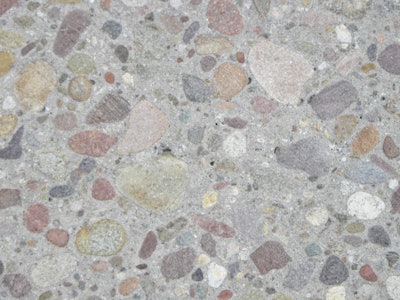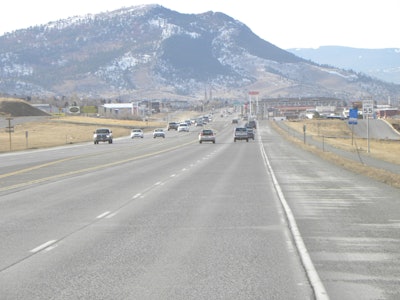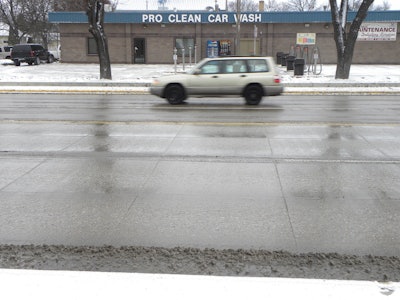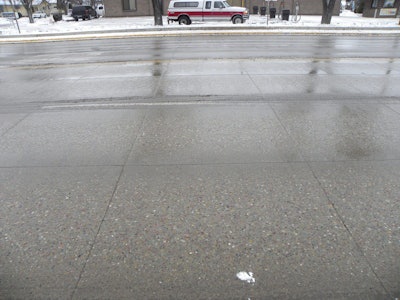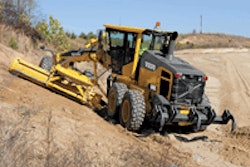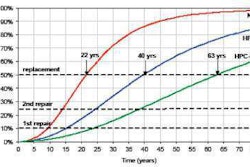This article was contributed by Dan Williams, a retired Highway Maintenance Reviewer from the Montana Department of Transportation
In this last decade, there have been a number of research efforts looking to define the impacts of long-term and repeated chemical applications to concrete. These accelerated tests have determined that there will be damage to concrete over time. So, because of my history with Montana Department of Transportation (MDT) with winter chemicals and maintenance, I went looking for actual damage in the field. (The following images were taken Jan. 19-20, 2011.)
I wanted “old” concrete, 20-year plus concrete that had been exposed to magnesium chloride and road salt. I was not disappointed. Montana, being a rural state, did not get a lot of concrete when the Interstate was being pushed through, but it got some. I-90, from Missoula northwest to Idaho, was a good example of original concrete. This stretch of road gets a lot of snow, freight traffic and winter chemicals. The oldest piece I looked at was 39 years old (milepost 89),and had seen Mg/Cl2 and road salt for the last 18 years. The surface is looking fine and has no plans for immediate work. Closer to the Idaho state line and increased snow fall, is milepost 43, and the concrete is 27 years old and in the same shape, good.

- Interstate 90 at milepost 89 (39 years old)
I jumped over to another wintery spot, Kalispell Montana, for another look-see. Main Street in Kalispell is full depth concrete constructed in 1982, and saw magnesium chloride expressly for 16 years as the town is PM-10 non-attainment (air quality status) meaning, no abrasives can be used. Same results – no damage.

- Interstate 90 at milepost 89 (39 years old) with a close-up of wheel path concrete
I looked at an experimental research ‘white-top’ project also in Kalispell being tracked by MDT on Idaho Street. It’s not old. Constructed in September 2000, this chunk of green concrete got the unthinkable, its first application of magnesium chloride one month after being open to traffic and it continued for the next six years until they switched to salt brine and solid chemical in 2006. Again, no damage.
I went closer to home to Helena where I retired from MDT four years ago. In front of the MDT headquarters runs a four lane piece of concrete (US 12) constructed in 1979 and it got its share of magnesium chloride and salt/sand for 12 years until they switched to salt brine and 75 percent salt/sand three years ago. Again, no damage.

- Highway 12 – looking west towards Helena and looking across the pavement. This photo was taken Jan. 28, 2011
When I say “no damage” I’m saying there is no apparent chemical damage that the lab research indicated would happen – concrete paste disintegrating. There is some studded tire wear, cracking with associated damage, tilted slabs and faulting here and there but not enough to merit anything but an occasional diamond grind to improve ride and a crack seal to keep water out.
These concrete roads are not only meeting their design life but exceeding it in some cases. An exception to this overall performance is a portion of I-90 at the summit of Look Out Pass that

- White-top experiment (11 years old with magnesium chloride on green concrete)
will receive a “crack and seat” with an asphalt overlay on top. Missoula District Administrator is Doug Moeller indicated, “This road may not be in the current condition it is today if water could be reduced from entering the sub-base.” And, he said he “was happy with the length of performance (30 years) of this piece of highway.” Doug’s observation about water damage is a reminder to all of us.
Long term testing of concrete will take 30 to 40 years in actual field conditions. Plus there are a number of variables in the field that can’t be controlled or measured in order to get an objective picture of chemical impacts.

- White-top experiment (11 years old with magnesium chloride on green concrete)
Consequently, methods have been developed to shorten the time of research to as little as two years. If successful, this accelerated approach has the benefit of preventing bad acting chemicals from future years of application to concrete to help ensure its longevity. And who is not for saving money and America’s infrastructure?
In my attempt to gather information about one of these recently completed pooled fund research projects, the South Dakota Study, I spoke with Ron Wright a member of that study and supervisor chemist for Idaho Transportation Department (ITD) as well as chemist for the Pacific Northwest Snowfighters (PNS). Wright noted, “There is no doubt that chloride penetration occurs from chloride based chemical applications, and the infusion depths of chlorides is linked to the quantity and types of materials used in chemical deicing.
“Research has studied the rapid effects of many chemical deicer composition,” Wright continues.” The rapid lab tests are conducted on concrete with poor mix designs to produce data quickly that can be extrapolated to what will potentially occur in the field. The problem is in identifying the life cycle of a durable concrete exposed to chemical deicers. Researchers have reported that some of the most destructive lab results will take many years, perhaps beyond the life span of the concrete, to show any negative effects on the chemical paste matrix and strength of a durable concrete place in the field. This fact has been confirmed by comparing rapid lab test results to actual field samples exposed to many years of exposure from the field.”
I think we know intuitively that chemicals don’t improve concrete performance or add to longevity. On the other hand, eliminating chemical applications for winter safety is not a realistic option at this point in time. We should avoid, if possible, excessive and prolonged use of chemicals. And, when conditions allow, flush our structures and water proof them every three or four years to prevent chemical intrusion. Bridges take a pounding from heavy freight and increased freeze/thaw cycling causing them uncommon distress.
As Ron mentioned, accelerated concrete testing relies in part on producing test sample bricks of poor quality such as reduced air voids and high water/cement ratios. Submit them to accelerated freeze/thaw cycling, wetting/drying cycles, high temperatures and an abundance of chemicals and you get “results.”
Those results, perhaps, go beyond simulating actual exposure of concrete to actual winters in Montana and actual usage of magnesium and sodium chlorides.
At the 2011 APWA North American Snow & Pacific Northwest Snowfighters Conference, held in mid-April in Spokane Wash., Purdue University Professors Jan Olek and Jason Weiss presented their concrete/chemical study results.
Their study confirmed some damage was caused by magnesium and, to a greater degree, calcium chlorides to concrete but to a much smaller degree than previously published studies have indicated. A portion of their research included the addition of fly ash to the concrete which nearly eliminated all damage from magnesium chloride. Their study went on to show why previous studies provided invalid results because of some accelerated test methods. From what I heard at this session, the greatest culprits to concrete damage are, and continue to be, poorly constructed concrete and the presence of water.
My personal advice to winter maintenance providers is to develop realistic and attainable Levels of Service (LOS) guidelines for your highway systems.
- Educate all of your employees involved and consider sharing these LOS guidelines with your customers as well.
- Select appropriate chemicals from an approved listing, such as the PNS, that will provide the kind of performance your winter conditions require.
- Select, calibrate and maintain quality equipment that will enable your crews to appropriately “place” the “correct” amount of chemical to meet their needs.
- Establish a variety of reliable weather information sources – use them.
- Construct your bridges with the best possible modern materials (including fly ash), and methods and then clean and dry.
- Crack seal ALL your roads to keep water out.
All too often, we look for a single cause for a failure when experience tells us it is likely a combination of factors. There is no substitute for common sense. Build it right, take care of it, and you will likely experience the same life cycle for concrete roadways that Montana is experiencing.
About the author: After 22 years, Dan Williams is a retired Highway Maintenance Reviewer with statewide responsibility to ensure quality work and methods and new technology. His focus was as the winter maintenance specialist and noxious weed manager. Williams represented MDT at the Pacific Northwest Snowfighters (PNS) Conferences and was one of the founding fathers. He also provided training and oversaw winter chemical use for most of the state as well as a public relations component. After retiring from Montana Department of Transportation, Williams spent several years as a senior research consultant with the Western Transportation Institute in Bozeman, Mont., at Montana State University working under Dr. Xianming Shi.

